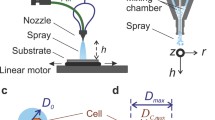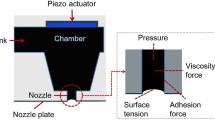Abstract
Cell printing, in which cell-laden droplets are delivered to target positions using inkjets or other devices, is an emerging technique in tissue engineering. Despite significant progress, the survival rate of cells delivered to these positions is often inadequate for targeted applications. Here, we developed a simple model for cell printing based on multiphase fluid–structure interactions. Using this model, we reconstructed the droplet and cell dynamics during the droplet impact process in cell printing. Based on extensive simulations, we developed a general picture of the droplet impact process by dividing it into four stages: the inertia stage, the interfacial flow stage, the elastic response stage, and the viscous flow stage. We provided a simple estimation of the duration of each stage and the magnitude of stress within the cell during each stage. From that estimation, we determined that surface tension is essential for controlling the deformation and stress inside cell under low-to-moderate droplet impact velocities relevant to inkjet-based cell printing. Based on extensive parametric studies, strategies for controlling the stress and deformation of cells during cell printing are examined and their practical implementations are discussed.












Similar content being viewed by others
References
Bagchi P (2007) Mesoscale simulation of blood flow in small vessels. Biophys J 92(6):1858–1877
Barron JA, Krizman DB, Ringeisen BR (2005) Laser printing of single cells: statistical analysis, cell viability, and stress. Ann Biomed Eng 33(2):121–130
Boland T, Mironov V, Gutowska A, Roth EA, Markwald RR (2003) Cell and organ printing 2: fusion of cell aggregates in three-dimensional gels. Anatomical Record Part A Discov Mol Cell Evol Biol 272A(2):497–502
Boland T, Xu T, Damon B, Cui X (2006) Application of inkjet printing to tissue engineering. Biotechnol J 1(9):910–917
Boland T, Tao X, Damon BJ, Manley B, Kesari P, Jalota S et al (2007) Drop-on-demand printing of cells and materials for designer tissue constructs. Mater Sci Eng C-Biomim Supramol Syst 27(3):372–376
Brackbill JU, Kothe DB, Zemach C (1992) A continuum method for modeling surface-tension. J Comput Phys 100(2):335–354
Calvert P (2007) Printing cells. Science 318(5848):208–209
Chen LQ, Li ZG (2010) Bouncing droplets on nonsuperhydrophobic surfaces. Phys Rev E 82(1):016308
Chen LQ, Xiao ZY, Chan PCH, Lee YK, Li ZG (2011) A comparative study of droplet impact dynamics on a dual-scaled superhydrophobic surface and lotus leaf. Appl Surf Sci 257(21):8857–8863
Chu KT, Prodanovic M (2013). LSMLIB package. http://ktchu.serendipityresearch.org/software/lsmlib
Colella P (1985) A direct Eulerian muscl scheme for gas-dynamics. SIAM J Sci Stat Comput 6(1):104–117
Collinsworth AM, Zhang S, Kraus WE, Truskey GA (2002) Apparent elastic modulus and hysteresis of skeletal muscle cells throughout differentiation. Am J Physiol Cell Physiol 283(4):C1219–C1227
Costa KD, Sim AJ, Yin FCP (2006) Non-Hertzian approach to analyzing mechanical properties of endothelial cells probed by atomic force microscopy. J Biomech Eng Trans ASME 128(2):176–184
Cui X, Boland T (2009) Human microvasculature fabrication using thermal inkjet printing technology. Biomaterials 30(31):6221–6227
Doddi SK, Bagchi P (2009) Three-dimensional computational modeling of multiple deformable cells flowing in microvessels. Phys Rev E 79(4):046318
Ferris CJ, Gilmore KG, Wallace GG, Panhuis MIH (2013) Biofabrication: an overview of the approaches used for printing of living cells. Appl Microbiol Biotechnol 97(10):4243–4258
Gross A, Schoendube J, Niekrawitz S, Streule W, Riegger L, Zengerle R et al (2013) Single-cell printer: automated, on demand, and label free. J Lab Autom 18(6):504–518
He P (2011) Fluid dynamics of cell printing, Ph.D. dissertation, Clemson University
He P, Qiao R (2011) A full-Eulerian solid level set method for simulation of fluid-structure interactions. Microfluid Nanofluid 11(5):557–567
Hsu SH, Strohl KP, Jamieson AM (1994) Role of viscoelasticity in tube model of airway reopening. 1. Nonnewtonian sols. J Appl Physiol 76(6):2481–2489
Jakab K, Neagu A, Mironov V, Forgacs G (2004) Organ printing: fiction or science. Biorheology 41(3–4):371–375
Jiang GS, Peng DP (2000) Weighted ENO schemes for Hamilton-Jacobi equations. SIAM J Sci Comput 21(6):2126–2143
Kamgoue A, Ohayon J, Tracqui P (2007) Estimation of cell young’s modulus of adherent cells probed by optical and magnetic tweezers: influence of cell thickness and bead immersion. J Biomech Eng Trans ASME 129(4):523–530
Kuznetsova TG, Starodubtseva MN, Yegorenkov NI, Chizhik SA, Zhdanov RI (2007) Atomic force microscopy probing of cell elasticity. Micron 38(8):824–833
Lanero T, Cavalleri O, Krol S, Rolandi R, Gliozzi A (2006) Mechanical properties of single living cells encapsulated in polyelectrolyte matrixes. J Biotechnol 124(4):723–731
Li Y, Cheng RS (2006) Viscometric study of gelatin in dilute aqueous solutions. J Polymer Sci Part B Polym Phys 44(13):1804–1812
Li Y, Gregory S (1974) Diffusion of ions in sea water and in deep-sea sediments. Geochim Cosmochim Acta 38:703–714
Li H, Ye T, Lam KY (2011) Qualitative and quantitative analysis of dynamic deformation of a cell in nonuniform alternating electric field. J Appl Phys 110(10):104701
Liberski AR, Delaney JT Jr, Schubert US (2011) “One cell-one well”: a new approach to inkjet printing single cell microarrays. ACS Comb Sci 13(2):190–195
Lim CT, Zhou EH, Quek ST (2006) Mechanical models for living cells—a review. J Biomech 39(2):195–216
Lin LAG, Liu AQ, Yu YF, Zhang C, Lim CS, Ng SH et al (2008) Cell compressibility studies utilizing noncontact hydrostatic pressure measurements on single living cells in a microchamber. Appl Phys Lett 92:233901
Luo ZY, Wang SQ, He L, Xu F, Bai BF (2013) Inertia-dependent dynamics of three-dimensional vesicles and red blood cells in shear flow. Soft Matter 9:9651–9660
Mathur AB, Collinsworth AM, Reichert WM, Kraus WE, Truskey GA (2001) Endothelial, cardiac muscle and skeletal muscle exhibit different viscous and elastic properties as determined by atomic force microscopy. J Biomech 34(12):1545–1553
Matsumoto T, Abe H, Ohashi T, Kato Y, Sato M (2002) Local elastic modulus of atherosclerotic lesions of rabbit thoracic aortas measured by pipette aspiration method. Physiol Meas 23(4):635–648
Mironov V, Boland T, Trusk T, Forgacs G, Markwald RR (2003) Organ printing: computer-aided jet-based 3D tissue engineering. Trends Biotechnol 21(4):157–161
Nakamura M, Kobayashi A, Takagi F, Watanabe A, Hiruma Y, Ohuchi K et al (2005) Biocompatible inkjet printing technique for designed seeding of individual living cells. Tissue Eng 11(11–12):1658–1666
Nestler FHM, Hvidt S, Ferry JD, Veis A (1983) Flexibility of collagen determined from dilute-solution viscoelastic measurements. Biopolymers 22(7):1747–1758
Ofori-Kwakye K, Martin GP (2005) Viscoelastic characterisation of calcium alginate gels intended for wound healing. J Sci Technol 25:46–52
Osher S, Fedkiw R (2002) Level set methods and dynamic implicit surfaces. Springer, New York
Pan KL, Law CK (2007) Dynamics of droplet-film collision. J Fluid Mech 587:1–22
Parsa S, Gupta M, Loizeau F, Cheung KC (2010) Effects of surfactant and gentle agitation on inkjet dispensing of living cells. Biofabrication 2(2):025003
Pasko A, Adzhiev V, Sourin A, Savchenko V (1995) Function representation in geometric modeling: concepts, implementation and applications. Vis Comput 11(8):429–446
Reasor D Jr, Mehrabadi M, Ku D, Aidun C (2013) Determination of critical parameters in platelet margination. Ann Biomed Eng 41(2):238–249
Ribeiro ACF, Sobral A, Simoes SMN, Barros MCF, Lobo VMM, Cabral A et al (2011) Transport properties of aqueous solutions of sodium alginate at 298.15 K. Food Chem 125(4):1213–1218
Ringeisen BR, Othon CM, Barron JA, Young D, Spargo BJ (2006) Jet-based methods to print living cells. Biotechnol J 1(9):930–948
Roth EA, Xu T, Das M, Gregory C, Hickman JJ, Boland T (2004) Inkjet printing for high-throughput cell patterning. Biomaterials 25(17):3707–3715
Saunders R, Gough J, Derby B (2005) Ink jet printing of mammalian primary cells for tissue engineering applications. Mater Res Soc Symp Proc 845:57–62
Saunders R, Gough JE, Derby B (2008) Delivery of human fibroblast cells by piezoelectric drop-on-demand inkjet printing. Biomaterials 29(2):193–203
Sethian JA (1999) Level set methods and fast marching methods. Cambridge University Press, Cambridge
Shu CW, Osher S (1988) Efficient implementation of essentially non-oscillatory shock-capturing schemes. J Comput Phys 77(2):439–471
Sussman M, Smereka P, Osher S (1994) A level set approach for computing solutions to incompressible 2-phase flow. J Comput Phys 114(1):146–159
Tanaka Y, Yamazaki Y, Okumura K (2003) Bouncing gel balls: impact of soft gels onto rigid surface. Europhys Lett 63(1):146–152
Tasoglu S, Kaynak G, Szeri AJ, Demirci U, Muradoglu M (2010) Impact of a compound droplet on a flat surface: a model for single cell epitaxy. Phys Fluids 22(8):082103
Tryggvason G, Bunner B, Esmaeeli A, Juric D, Al-Rawahi N, Tauber W et al (2001) A front-tracking method for the computations of multiphase flow. J Comput Phys 169(2):708–759
Varghese D, Deshpande M, Xu T, Kesari P, Ohri S, Boland T (2005) Advances in tissue engineering: cell printing. J Thorac Cardiovasc Surg 129(2):470–472
Villar G, Graham AD, Bayley H (2013) A tissue-like printed material. Science 340(6128):48–52
Wang W, Huang Y, Grujicic M, Chrisey DB (2008) Study of impact-induced mechanical effects in cell direct writing using smooth particle hydrodynamic method. J Manuf Sci Eng Trans ASME 130(2):021012
Winterhalter M (2000) Black lipid membranes. Curr Opin Colloid Interface Sci 5(3–4):250–255
Withers GS (2006) New ways to print living cells promise breakthroughs for engineering complex tissues in vitro. Biochem J 394:e1–e2
Xu T, Petridou S, Lee EH, Roth EA, Vyavahare NR, Hickman JJ et al (2004) Construction of high-density bacterial colony arrays and patterns by the ink-jet method. Biotechnol Bioeng 85(1):29–33
Xu T, Jin J, Gregory C, Hickman JJ, Boland T (2005) Inkjet printing of viable mammalian cells. Biomaterials 26(1):93–99
Xu T, Gregory CA, Molnar P, Cui X, Jalota S, Bhaduri SB et al (2006) Viability and electrophysiology of neural cell structures generated by the inkjet printing method. Biomaterials 27(19):3580–3588
Xu T, Olson J, Zhao WX, Atala A, Zhu JM, Yoo JJ (2008) Characterization of cell constructs generated with inkjet printing technology using in vivo magnetic resonance imaging. J Manuf Sci Eng Trans ASME 130(2):021013
Xu T, Rohozinski J, Zhao W, Moorefield EC, Atala A, Yoo JJ (2009) Inkjet-mediated gene transfection into living cells combined with targeted delivery. Tissue Eng Part A 15(1):95–101
Xu CX, Chai WX, Huang Y, Markwald RR (2012) Scaffold-free inkjet printing of three-dimensional zigzag cellular tubes. Biotechnol Bioeng 109(12):3152–3160
Yamaguchi S, Ueno A, Akiyama Y, Morishima K (2012) Cell patterning through inkjet printing of one cell per droplet. Biofabrication 4(4):045005
Ye Z (2000) On the low frequency elastic response of a spherical particle. Chinese J Phys 38(2):103–110
Ye T, Li H, Lam KY (2011) Numerical design of microfluidic-microelectric hybrid chip for the separation of biological cells. Langmuir 27(6):3188–3197
Yeung A, Evans E (1989) Cortical shell-liquid core model for passive flow of liquid-like spherical cells into micropipets. Biophys J 56(1):139–149
Youn S, Lee DW, Cho YH (2008) Cell-deformability-monitoring chips based on strain-dependent cell-lysis rates. J Microelectromech Syst 17(2):302–308
Zang Y, Street RL, Koseff JR (1994) A non-staggered grid, fractional step method for time-dependent incompressible Navier–Stokes equations in curvilinear coordinates. J Comput Phys 114(1):18–33
Zhao H, Freund JB, Moser RD (2008) A fixed-mesh method for incompressible flow-structure systems with finite solid deformations. J Comput Phys 227(6):3114–3140
Zienkiewicz OC, Zhu JZ (1992) The superconvergent patch recovery and a posteriori error estimates. 1. The recovery technique. Int J Numer Meth Eng 33(7):1331–1364
Acknowledgments
All authors gratefully acknowledge support from NSF under Grant No. CBET-0936235. P.H. was also partially supported by the Natural Science Foundation of Jiangsu Province (Grant No. BK20130597), the Specialized Research Funds for Doctoral Program of Higher Education of China (Grant No. 20130092120021), and the Fundamental Research Funds for the Central Universities (Grant No. 22420135013). The authors thank the Clemson-CCIT office for allocation of computer time on the Palmetto cluster and Godfrey Kimball for proofreading the manuscript.
Author information
Authors and Affiliations
Corresponding author
Electronic supplementary material
Below is the link to the electronic supplementary material.
Rights and permissions
About this article
Cite this article
He, P., Liu, Y. & Qiao, R. Fluid dynamics of the droplet impact processes in cell printing. Microfluid Nanofluid 18, 569–585 (2015). https://doi.org/10.1007/s10404-014-1470-3
Received:
Accepted:
Published:
Issue Date:
DOI: https://doi.org/10.1007/s10404-014-1470-3




